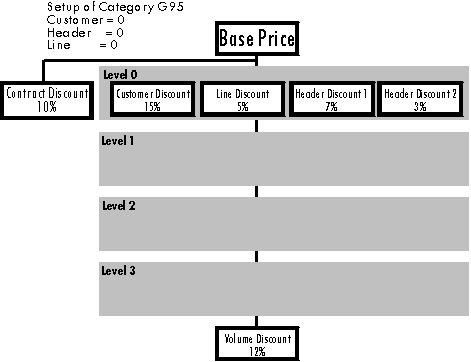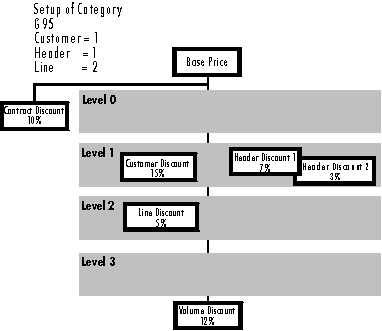Documentation >
MAC-PAC Reference Library >
Distribution >
Order Processing >
Key Concepts and Procedures >
Discounting Methods >
Applying Discounts to Orders
Applying Discounts to Orders
Discounts can be applied in the sales/quote order maintenance, shipping/billing, or postbilling conversations as long as the value of the Apply Discounts flag is set to 'Y.' If active in the system discount codes can be defaulted, entered manually, or retrieved using a discount template. Below is a summary of ways each of the discount types can be applied.
|
|
Methods of Applying Discounts to Orders
|
|
|
|
|
|
|
Contract
|
Y
|
N
|
N
|
|
Customer
|
Y
|
Y
|
N
|
|
Volume
|
Y
|
Y
|
Y
|
|
Header
|
N
|
Y
|
N
|
|
Line
|
Y
|
N
|
Y
|
Note: Defaults for line discounts are not stored on a MAC-PAC file. They are dynamically applied based on the order header and line characteristics. If the order characteristics either match the values of the user-defined pricing/discounting key fields or a discount templates key fields, the line discount is applied.
Regardless of how they are entered, customer, header, and line discounts are applied to orders according to a discount hierarchy established in Reference File category G95 - Discount Hierarchy. Processing for the other discount types is automatically determined—contractual discounts are always applied directly to the base price, volume discounts are always applied after all other discounts.
Apply Discount Flag
The Apply Discount flag determines whether discounts can be applied to the base price of an order line. The valid values for this field are Y (yes, allow discounts to be applied to this order line) and N (no, do not allows discounts to be applied to this order line). The value of this field may be changed as long as the Firm Price flag is not equal to Y (yes).
Discount Hierarchy
Reference File category G95 - Discount Hierarchy, shown below, allows you to determine the method in which discounts are applied to the base price of a sales or quote order line. Discount hierarchies are defined for each company/location on the system. If you do not wish to use a complex discounting structure, do not set up a record on category G95 and the hierarchy will default to values of 000.
WILLIAMS COMMON FEATURES 5/24/94
DSP01 REFERENCE FILE CATEGORY G95 CHANGE
Category Name DISCOUNT HIERARCHY
CO(3) LOC(3)
Category Key 001BEL
CUSTOMER HEADER LINE
Data 0 1 2
N N N
Data
Data
F2=Command F3=Exit F9=Inquiry F10=Function Select
F12=Lower Case F15=Rekey Data
|
Reference File Category G95 - Discount Hierarchy.
This category allows you to determine how discounts are applied to orders.
You can determine processing for three types of discounts: customer, header, and line. The values established effect the sales/quote order lines' discount amounts and calculated unit prices. Valid values are:
0 - Apply the discount to the base price.
1 - Apply the discount to the base price after all 0 level discounts are applied.
2 - Apply the discount to the base price after all 0 and 1 level discounts are applied.
3 - Apply the discount to the base price after all 0, 1, and 2 level discounts are applied.
Note: You can enter up to five header discounts on one order. If you choose level 0 for header discounts, all applicable header discounts will be applied to the base price. If you specify level 1, 2, or 3, each applicable header discount will be applied to the net result of the pervious header discount calculation within that level.
Example 1: Simple Discounting
In the first example, you want to apply customer, header, and line discounts to the base price. As always, contract discounts are applied to the base price and volume discounts are applied after all other discounts.

Simple Discounting Structure.
Assuming that the base price is $200.00, the price applied to the line would be calculated as:
|
Contract Discount
|
200
|
x
|
10%
|
=
|
20.00
|
|
Customer Discount
|
200
|
x
|
15%
|
=
|
30.00
|
|
Line Discount
|
200
|
x
|
5%
|
=
|
10.00
|
|
Header Discount 1
|
200
|
x
|
7%
|
=
|
14.00
|
|
Header Discount 2
|
200
|
x
|
3%
|
=
|
6.00
|
|
|
|
|
|
|
80.00
|
|
|
|
|
|
|
|
|
Subtotal
|
200
|
¾
|
80
|
=
|
120.00
|
|
|
|
|
|
|
|
|
Volume Discount:
|
120
|
x
|
12%
|
=
|
14.40
|
|
|
|
|
|
|
|
|
Total Price
|
120
|
¾
|
14.4
|
=
|
$105.60
|
Example 2: Complex Discounting
In the second example, you want to apply customer and header discounts to the net of level 0 discounts and line discounts to the net of level 1 discounts. As always, contract discounts are applied to the base price and volume discounts are applied after all other discounts.

Complex Discounting Structure.
Assuming that the base price is $200.00, the price applied to the line would be calculated as:
|
Contract Discount
|
200
|
x
|
10%
|
=
|
20.00
|
|
Subtotal
|
200
|
‑
|
20
|
=
|
180.00
|
|
|
|
|
|
|
|
|
Customer Discount
|
180
|
x
|
15%
|
=
|
27.00
|
|
Header Discount 1
|
180
|
x
|
7%
|
=
|
12.60
|
|
Header Discount 2
|
(180 - 12.6)
|
x
|
3%
|
=
|
5.02
|
|
|
|
|
|
|
44.62
|
|
|
|
|
|
|
|
|
Subtotal
|
180
|
¾
|
44.62
|
=
|
135.38
|
|
|
|
|
|
|
|
|
|
|
|
|
|
|
|
|
|
|
Line Discount
|
135.38
|
x
|
5%
|
=
|
6.77
|
|
|
|
|
|
|
|
|
Subtotal
|
135.38
|
¾
|
6.77
|
=
|
128.61
|
|
|
|
|
|
|
|
|
Volume Discount
|
128.61
|
x
|
12%
|
=
|
15.43
|
|
|
|
|
|
|
|
|
Total Price
|
128.61
|
¾
|
15.43
|
=
|
$113.18
|
Effectivity Dates
The discount start date determines the discount's eligibility. You can have multiple variations of a discount, but only one, open-ended start date. To be eligible for a discount, the order's pricing date must be greater than or equal to the discount start date. Volume and header discounts use the header-level pricing date to determine eligibility; line and contractual discounts use the line-level pricing date.
Multiple Currencies
In multi-currency environments, discounts are associated with a specific currency code. When entered on an order, the discount will only be applied if the order selling currency and the discount currency are the same.